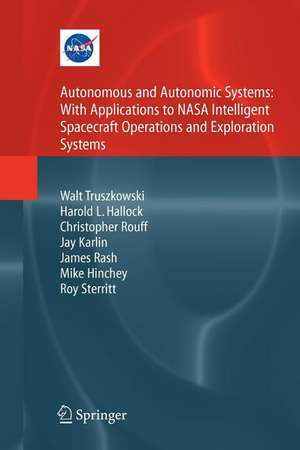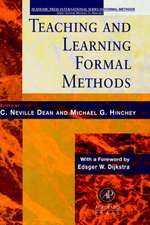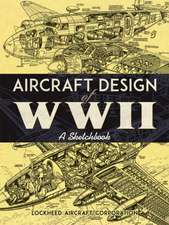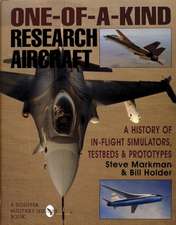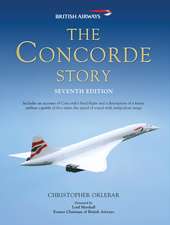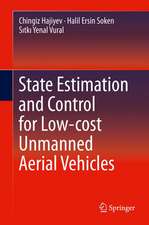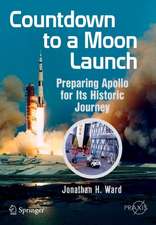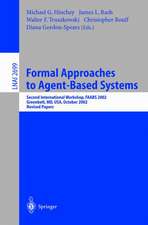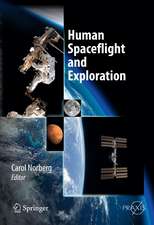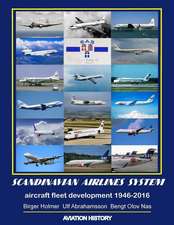Autonomous and Autonomic Systems: With Applications to NASA Intelligent Spacecraft Operations and Exploration Systems: NASA Monographs in Systems and Software Engineering
Autor Walt Truszkowski, Harold Hallock, Christopher Rouff, Jay Karlin, James Rash, Michael Hinchey, Roy Sterritten Limba Engleză Paperback – mar 2012
| Toate formatele și edițiile | Preț | Express |
|---|---|---|
| Paperback (1) | 1380.78 lei 6-8 săpt. | |
| SPRINGER LONDON – mar 2012 | 1380.78 lei 6-8 săpt. | |
| Hardback (1) | 1386.80 lei 6-8 săpt. | |
| SPRINGER LONDON – 9 dec 2009 | 1386.80 lei 6-8 săpt. |
Preț: 1380.78 lei
Preț vechi: 1683.87 lei
-18% Nou
Puncte Express: 2071
Preț estimativ în valută:
264.21€ • 275.86$ • 218.67£
264.21€ • 275.86$ • 218.67£
Carte tipărită la comandă
Livrare economică 04-18 aprilie
Preluare comenzi: 021 569.72.76
Specificații
ISBN-13: 9781447125266
ISBN-10: 1447125266
Pagini: 308
Ilustrații: XVII, 289 p. 56 illus.
Dimensiuni: 155 x 235 x 16 mm
Greutate: 0.44 kg
Ediția:2010
Editura: SPRINGER LONDON
Colecția Springer
Seria NASA Monographs in Systems and Software Engineering
Locul publicării:London, United Kingdom
ISBN-10: 1447125266
Pagini: 308
Ilustrații: XVII, 289 p. 56 illus.
Dimensiuni: 155 x 235 x 16 mm
Greutate: 0.44 kg
Ediția:2010
Editura: SPRINGER LONDON
Colecția Springer
Seria NASA Monographs in Systems and Software Engineering
Locul publicării:London, United Kingdom
Public țintă
ResearchCuprins
From the contents
Part I Background.- Introduction.- Direction of New Space Missions.- Overview of Flight and Ground Software.- Flight vs. Ground Implementation.- Flight Autonomy Evolution.- Current Levels of Flight Automation/Autonomy.-Ground Autonomy Evolution.- Agent Concept Testbed.- Part II Technology.- Core Technologies for Developing Autonomous and Autonomic Systems.- Reasoning with Partial Information.- Agent-based Spacecraft Autonomy Design Concepts.- Spacecraft Enabling Technologies.- Cooperative Autonomy.- Need for Cooperative Autonomy in Space Missions.- Autonomic Systems.- Overview of Autonomic Systems.- Part III Applications.- Intelligent Agents in Space Constellations.- Swarms in Space Missions.- Swarm Technologies at NASA.- Concluding Remarks.- Future Missions.- Appendix A: Attitude and Orbit Determination and Control.- Appendix B: Operational Scenarios and Agent Interactions.- Acronyms.- Glossary.- References.- Index.
Part I Background.- Introduction.- Direction of New Space Missions.- Overview of Flight and Ground Software.- Flight vs. Ground Implementation.- Flight Autonomy Evolution.- Current Levels of Flight Automation/Autonomy.-Ground Autonomy Evolution.- Agent Concept Testbed.- Part II Technology.- Core Technologies for Developing Autonomous and Autonomic Systems.- Reasoning with Partial Information.- Agent-based Spacecraft Autonomy Design Concepts.- Spacecraft Enabling Technologies.- Cooperative Autonomy.- Need for Cooperative Autonomy in Space Missions.- Autonomic Systems.- Overview of Autonomic Systems.- Part III Applications.- Intelligent Agents in Space Constellations.- Swarms in Space Missions.- Swarm Technologies at NASA.- Concluding Remarks.- Future Missions.- Appendix A: Attitude and Orbit Determination and Control.- Appendix B: Operational Scenarios and Agent Interactions.- Acronyms.- Glossary.- References.- Index.
Recenzii
From the reviews:
“Truszkowski (NASA Goddard Space Flight Center) and colleagues have documented how NASA missions have become and will become more autonomous and automatic. … The authors present several top-level examples along with … helpful flowcharts. … A thorough glossary and nearly 200 references provide a good basis for diving into more depth with other resources. This book would be a start for someone who is developing autonomous and automatic systems. … Summing Up: Recommended. Professional audiences.” (D. B. Spencer, Choice, Vol. 47 (11), July, 2010)
“Truszkowski (NASA Goddard Space Flight Center) and colleagues have documented how NASA missions have become and will become more autonomous and automatic. … The authors present several top-level examples along with … helpful flowcharts. … A thorough glossary and nearly 200 references provide a good basis for diving into more depth with other resources. This book would be a start for someone who is developing autonomous and automatic systems. … Summing Up: Recommended. Professional audiences.” (D. B. Spencer, Choice, Vol. 47 (11), July, 2010)
Textul de pe ultima copertă
Technologies enabling autonomous and autonomic behaviors of spacecraft have steadily progressed, but, as argued in this book, need to be extended much farther to enable success of the most advanced un-crewed space-mission concepts in the future.
This book describes these technologies and their relevance not only for NASA space missions that have flown, but also for advanced future mission concepts. Early parts of the book present general background information on space missions that have flown, including mission design and operations, followed by descriptions of future mission concepts, all in relation to autonomy and autonomic capabilities.
Readers will find chapters on flight and ground software and evolution of flight and ground autonomy, as well as chapters on technologies for developing autonomic systems, agent-based autonomy, cooperative autonomy, constellation missions, and swarm missions. One appendix covers spacecraft attitude and orbit determination and control, and a second appendix describes operational scenarios supported by agent interactions.
No specialized background is needed to absorb the material in this book. The material is relevant to students in aerospace science or engineering, and is a useful source of supplementary material for more advanced engineering courses.
This book describes these technologies and their relevance not only for NASA space missions that have flown, but also for advanced future mission concepts. Early parts of the book present general background information on space missions that have flown, including mission design and operations, followed by descriptions of future mission concepts, all in relation to autonomy and autonomic capabilities.
Readers will find chapters on flight and ground software and evolution of flight and ground autonomy, as well as chapters on technologies for developing autonomic systems, agent-based autonomy, cooperative autonomy, constellation missions, and swarm missions. One appendix covers spacecraft attitude and orbit determination and control, and a second appendix describes operational scenarios supported by agent interactions.
No specialized background is needed to absorb the material in this book. The material is relevant to students in aerospace science or engineering, and is a useful source of supplementary material for more advanced engineering courses.
Caracteristici
Unique combination of spacecraft, autonomous and autonomic systems
